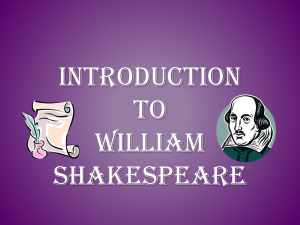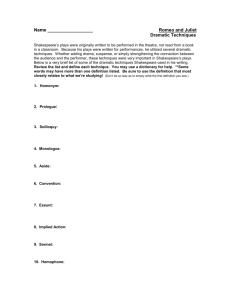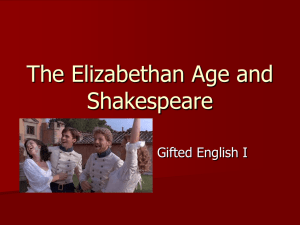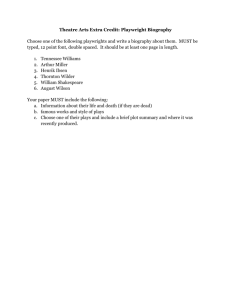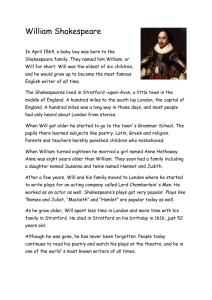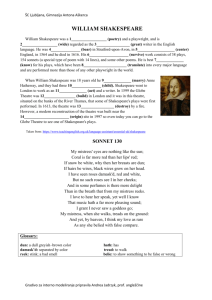Spring Semester Exam Review Answers
advertisement
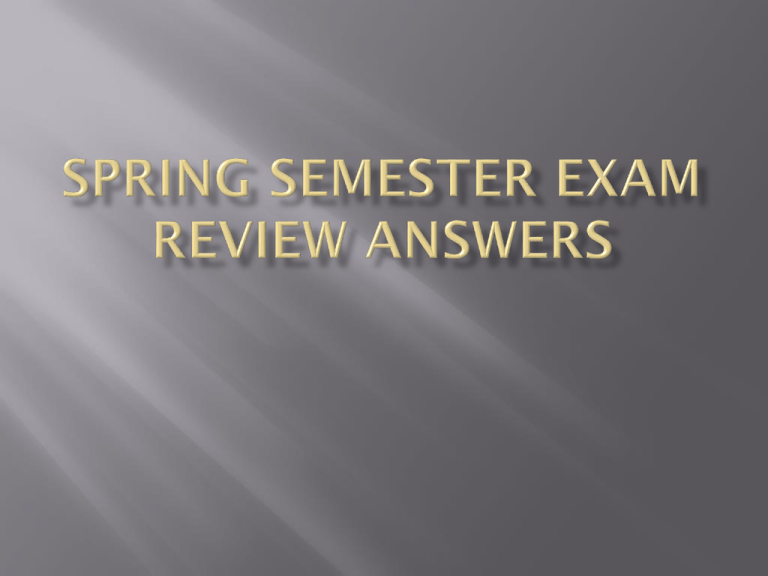
What are the five rules for Improv? Say yes- and!, After the ‘and’ add new information, Don’t Block, Avoid Questions, Establish Character and setting What plays were based mainly on stories from the Bible? Mystery What type of plays were based on the last week in the life of Christ? Passion Which plays focused on the principles of right and wrong? Morality Which pays dramatized the lives of the Saints? Miracle What were short dramatized scenes added to the church services? Tropes What were Medieval groups of trades and craftsmen called? Guilds What was a multi-level cart that doubled as a stage called? Pageant Wagon What is a series of short plays based on religious history called? Cycle What is the main theme in a medieval morality play? Salvation What does allegory mean? A symbolic narrative; the representation of abstract ideas by characters Who is the main character in medieval morality plays? Everyman Everyman is an example of what type of play? Morality Why did the church revive theatre during the medieval era? To be able to teach the people about their faith. Where did wealthy patrons sit in an Elizabethan theatre? galleries The area in front of the stage in an Elizabethan theatre? Pit People who paid a penny to stand and see a play in an Elizabethan theater were called? Groundlings What was the name of Shakespeare’s theater? The Globe How did people know a play was being presented in Elizabethan England? A flag was raised Where and when was Shakespeare born? Stratford upon Avon, April 23, 1564 How many plays did Shakespeare write? 37 Who were the two reigning monarchs during Shakespeare’s time? Elizabeth I and King James What is the name of the theatre troupe William Shakespeare joined when he first arrived in London in 1594? The Lord Chamberlain’s Men What was the name of the roof over the stage area? Heaven Who acted in the plays? Men and Boys What were the plays like? 2 hours, fast paced, little to no scenery When were Shakespeare’s plays published? Do not need to answer What type of plays did Shakespeare write? Histories, Comedies, Tragedies Describe what Shakespeare’s theatre looked like? (In your own words) Who was William Shakespeare and why is he considered the greatest playwright of the English language? (In your own words) Unity- A situation in which all elements of the set form a perfect whole, centering on the idea of the play. Balance- The visual symmetry of the stage. Emphasis- The focus of the audience’s attention on some part of the stage. Proportion- Stage setting that takes the human being as the unit of measure. Flat- A wooden frame covered with cloth or plywood. Purple- mournful, mystic, rich, regal Red- aggression, passion, bloody, strength, love Black- power, melancholy, tragic, gloomy, death, mystery Blue- calm, cold, formal, spiritual, truthful, depression Scenic Designer- The person who is responsible for designing the physical appearance of the stage for a production. Blocking- movement of the actors on stage. Unit Set- a basic stage setting from which several setting can be created. Permanent Set- a set that remains the same throughout a play, regardless of change of locale. Box Set- a two wall or three wall set representing an interior of a room, often covered by a ceiling. Fourth wall- the imaginary wall through which the audience watches the action of the play. Theatre- a building used for the presentation of plays. Purpose of Scenery- define time, setting, and provide the actors and area to act on. Green- youthful, eternal, reborn, growth, jealousy Brown- earthy, common, poverty Orange- exhilaration, cheerful, lively Yellow- cheerful, happy, youthful, cowardly White- truthful, pure, innocent, peaceful Backdrop- Large piece of fabric on which scenery is painted. Texture- The appearance/ feel of a surface Atmosphere- the environment of the play created by stage and lighting. Stock Characters- a character with a recognizable set of traits that remain the same from play to play. Renaissance- began in Italy, with a rediscovery of the classics. Means rebirth. Brighalla- The tough guy servant, a good liar, always out for himself. Usually a shopkeeper. Proscenium Arch- the arch opening between the stage and the auditorium. Columbina- The wise-cracking maid, usually the smartest character; flirtatious, playful, servant to the leading lady and Arlecchino’s girlfriend. Zanni- The poorest, stupidest, and hungriest, servant. Sleeps on the job, sneaks off to ear food and daydream. Cannot do what he is told very well at all. Arlecchino- Nimble, acrobatic, tricky servant. Childlike, not too bright. Innamorati- They were young, graceful, and attractive. They wore fashionable clothes and no masks. They were slightly vain and not too bright– in love with themselves a bit too much– but they were sincere. II Captiano-a boasting, bragging macho soldier, who tells tall tales of victory but is actually a coward underneath. II’ Dottore- the Doctor- a smug, “know it all” professor, who really knows nothing. Pantolone- “Mr, Big Pants” A waalthy, miserly old man. Italy- The birth place of the Renaissance and Commedia Del Arte. Moliere- Most important playwright of the French Renaissance. Lazzi-Joke, comic “bits” gags. Each character had his or her typical lazzi that they could draw on in any situation. Scenario- Outline that the Commedia actors used for their skits. Actors improvised dialogue and action tailoring to the day’s audience.

